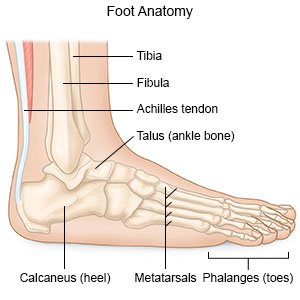Transmetatarsal Amputation
Medically reviewed by Drugs.com. Last updated on Aug 4, 2025.
Transmetatarsal amputation (TMA) is surgery to remove all or part of your forefoot. You may need TMA if you have a severe injury or infection, or poor blood flow to your foot.
 |
WHILE YOU ARE HERE:
Before your surgery:
- Informed consent is a legal document that explains the tests, treatments, or procedures that you may need. Informed consent means you understand what will be done and can make decisions about what you want. You give your permission when you sign the consent form. You can have someone sign this form for you if you are not able to sign it. You have the right to understand your medical care in words you know. Before you sign the consent form, understand the risks and benefits of what will be done. Make sure all your questions are answered.
- An IV will be placed into a vein. You may be given liquid or medicine through the IV.
- Anesthesia is medicine to make you comfortable during the surgery. Healthcare providers will work with you to decide which anesthesia is best for you.
- General anesthesia will keep you asleep and free from pain during surgery. Anesthesia may be given through your IV. You may instead breathe it in through a mask or a tube placed down your throat. The tube may cause you to have a sore throat when you wake up.
- Spinal anesthesia numbs the area and dulls the pain. You may still feel pressure or pushing during surgery.
During your surgery:
- Your surgeon will make incisions on your forefoot. Any damaged or infected bones will be cut and removed. Nerves, tendons, and blood vessels will be cut and closed off. Your surgeon will remove any infected or dead tissue and clean the inside of your foot. If the infection is severe, your incision wound will be packed with medical bandages and left open to heal.
- If your foot is not infected, the incision will be closed with stitches or staples. A skin graft from a donor or another part of your body may be used to cover your incision wound. One or more drains may be placed to remove extra blood and fluid from your wound. Bandages will be placed on your wound to help prevent bleeding and inflammation.
Related medications
After your surgery:
You will be taken to a room to rest until you are fully awake. Healthcare providers will monitor you closely for any problems. Do not get out of bed until your healthcare provider says it is okay. When your healthcare provider sees that you are okay, you may be able to go home.
- Use support devices as directed. You may need to use crutches or a wheelchair so you do not put any weight on your foot. Your healthcare provider will tell you when you can walk on your foot again.
- You may need to walk around the same day of surgery, or the day after. Movement will help prevent blood clots. You may also be given exercises to do in bed. Do not get out of bed on your own until your healthcare provider says you can. Talk to healthcare providers before you get up the first time. They may need to help you stand up safely. When you are able to get up on your own, sit or lie down right away if you feel weak or dizzy. Then press the call light button to let healthcare providers know you need help.
- You will be able to eat and drink gradually after surgery. You will begin with ice chips or clear liquids such as water, broth, juice, and clear soft drinks. If your stomach does not become upset, you may then eat soft foods, such as ice cream and applesauce. Once you can eat soft foods easily, you may slowly begin to eat solid foods.
- A physical therapist teaches you exercises to help improve movement and strength, and to decrease pain. You may be fitted with a medical device that helps protect, support, or improve the function of your foot.
- Medicines may be given to relieve pain or to prevent an infection.
RISKS:
You may bleed more than expected or get an infection. Your nerves or blood vessels may be damaged. You may have trouble walking after surgery. You may continue to feel the part of your foot that has been removed. You may get a blood clot in your limb. This may become life-threatening.
CARE AGREEMENT:
You have the right to help plan your care. Learn about your health condition and how it may be treated. Discuss treatment options with your healthcare providers to decide what care you want to receive. You always have the right to refuse treatment.© Copyright Merative 2025 Information is for End User's use only and may not be sold, redistributed or otherwise used for commercial purposes.
The above information is an educational aid only. It is not intended as medical advice for individual conditions or treatments. Talk to your doctor, nurse or pharmacist before following any medical regimen to see if it is safe and effective for you.
Further information
Always consult your healthcare provider to ensure the information displayed on this page applies to your personal circumstances.
